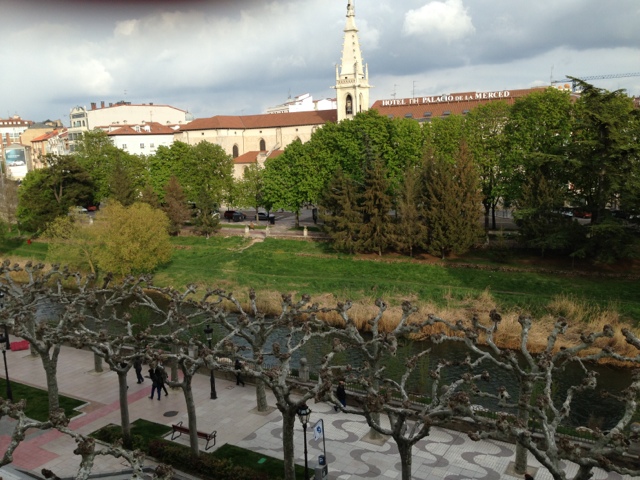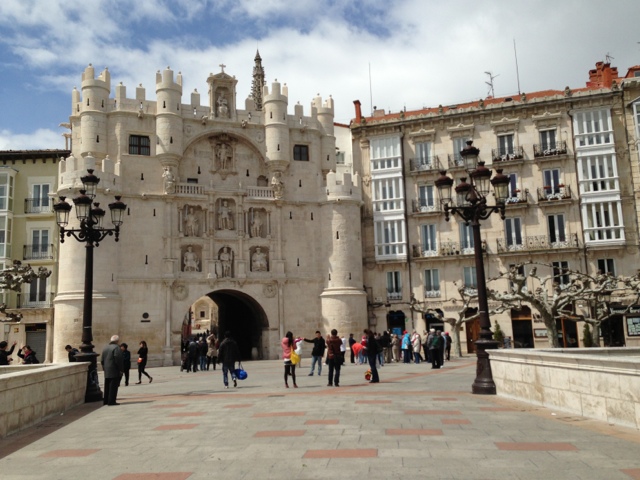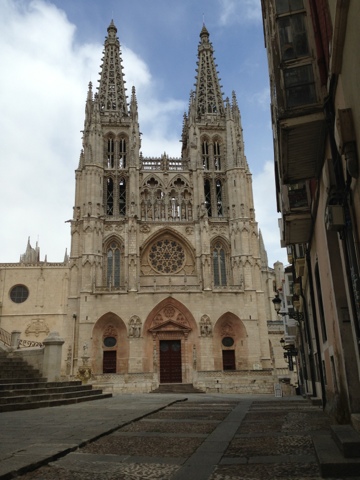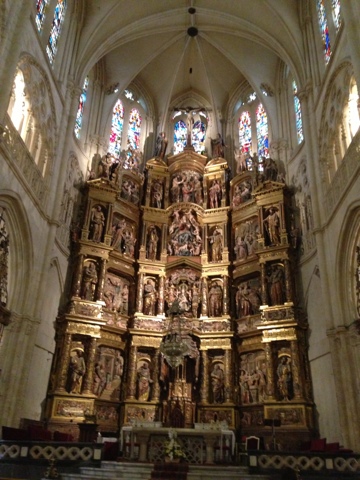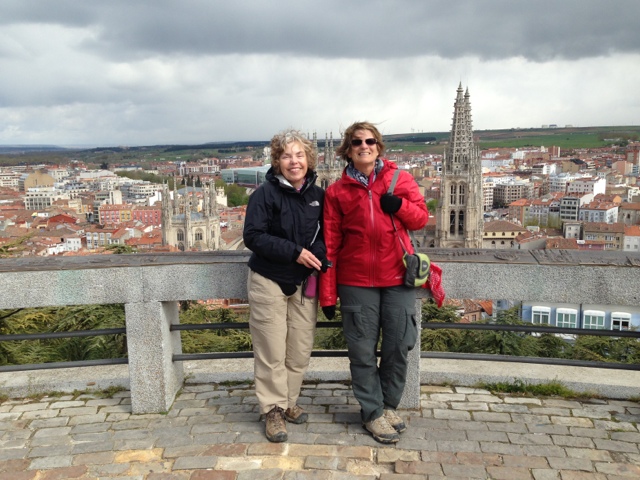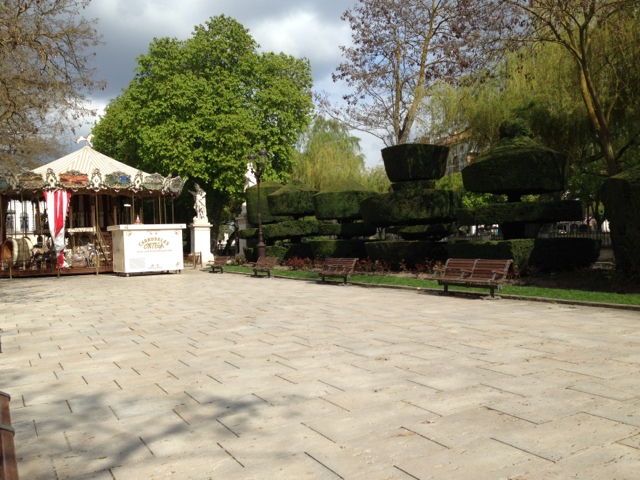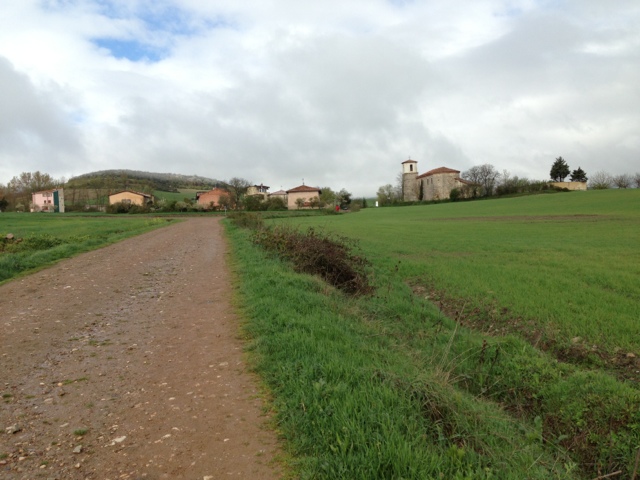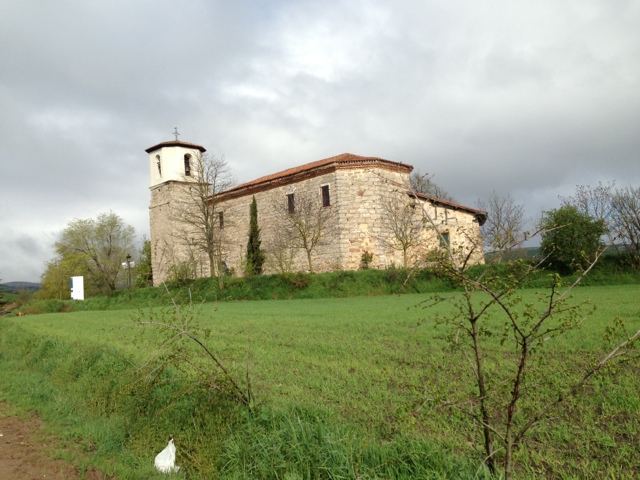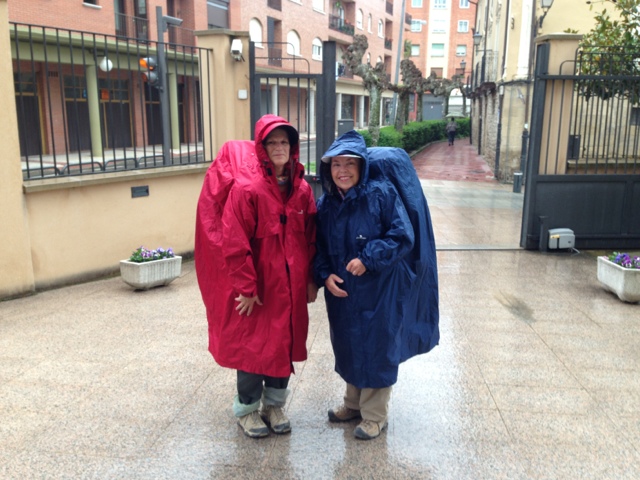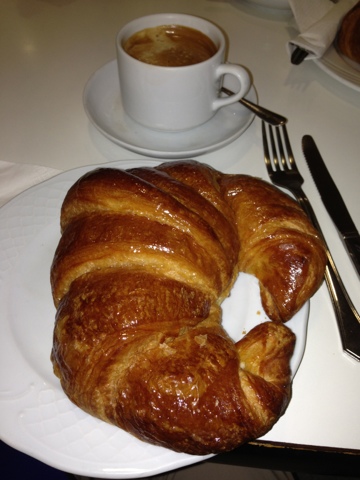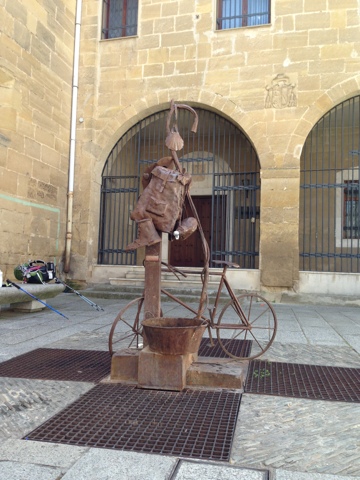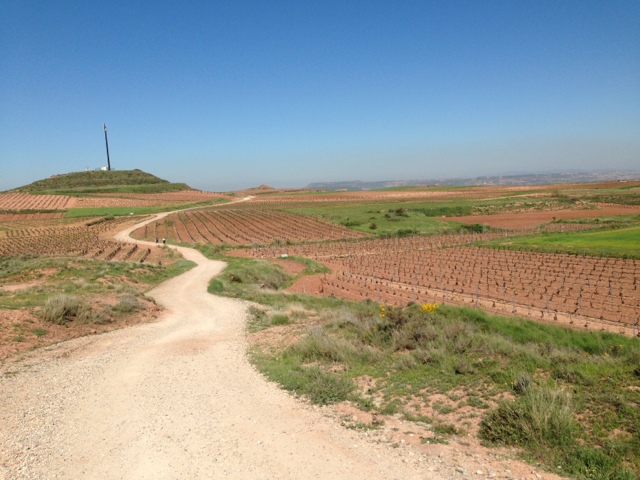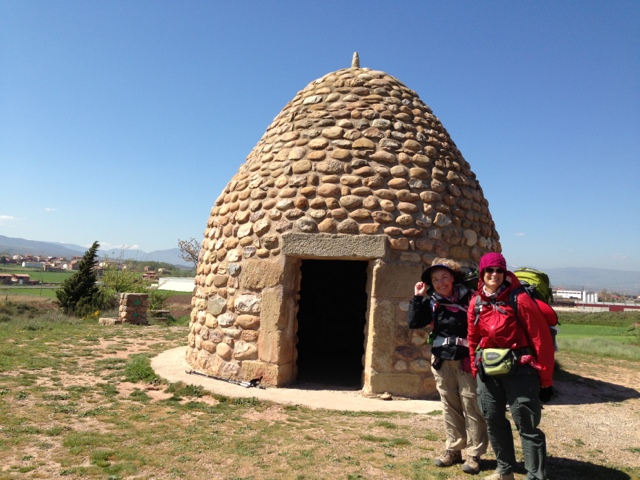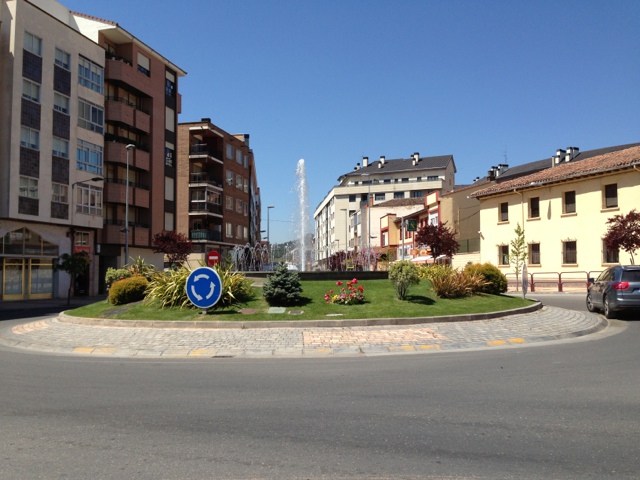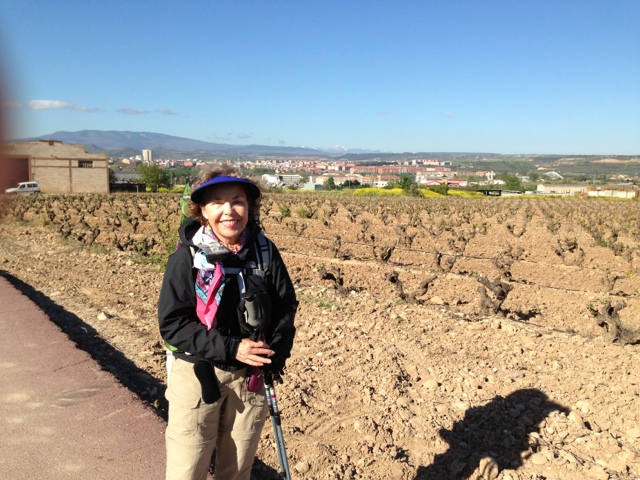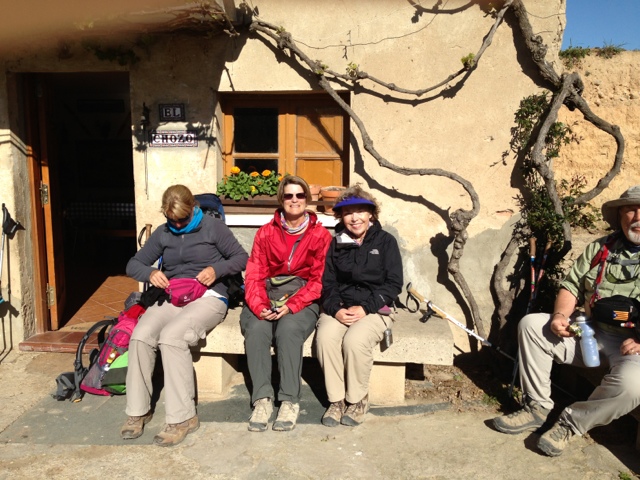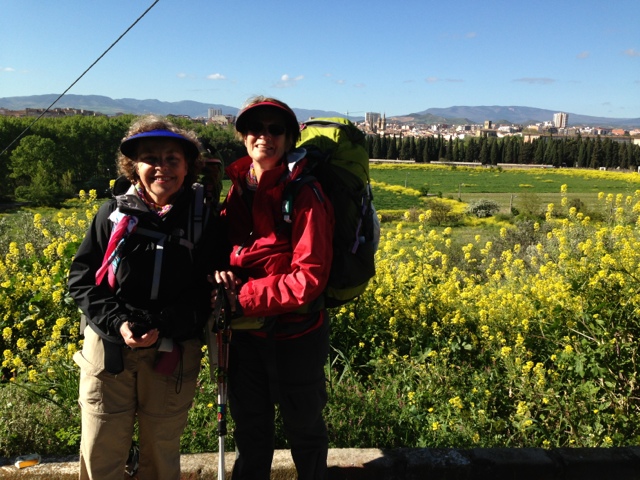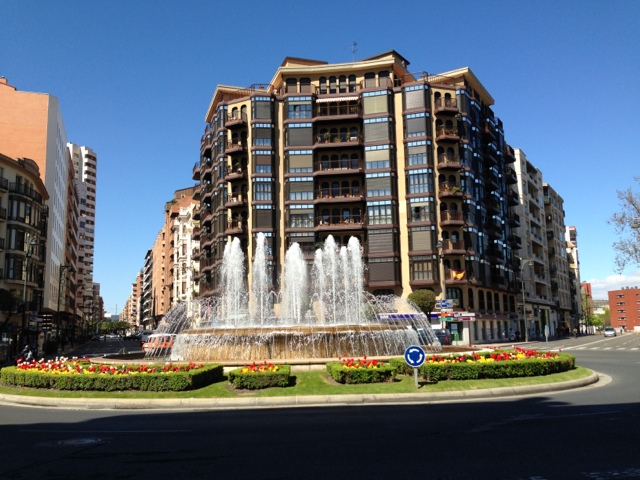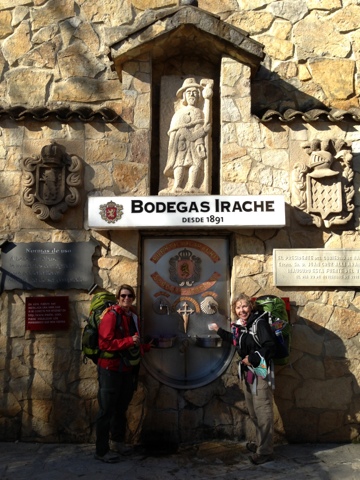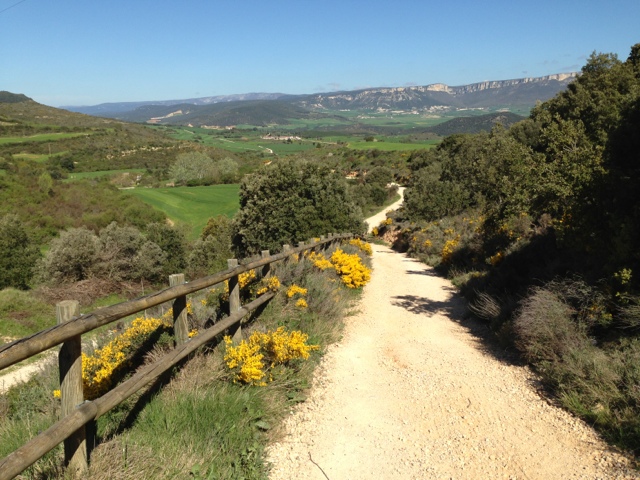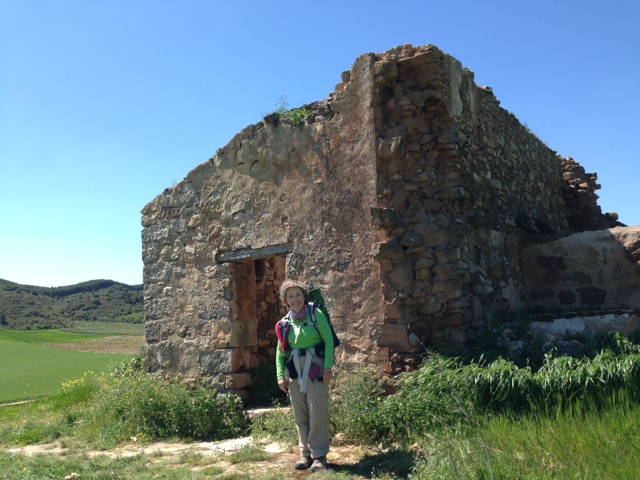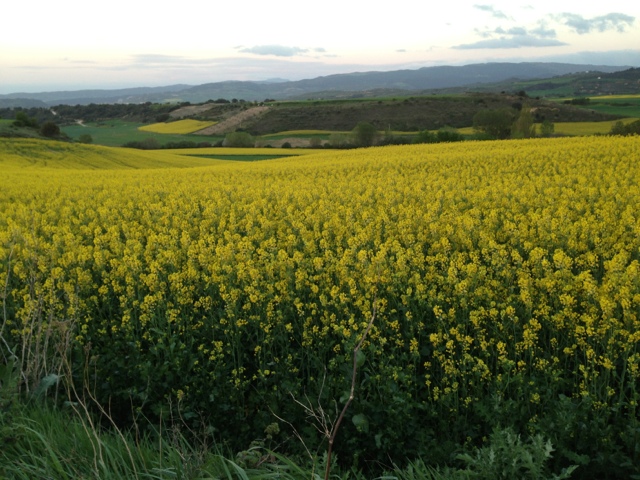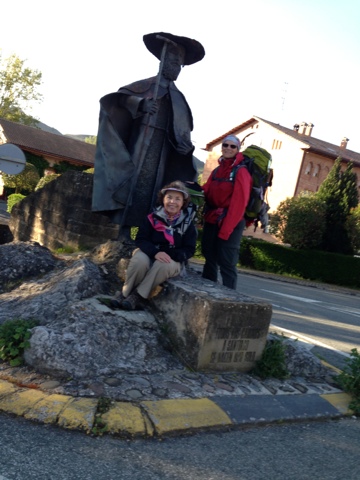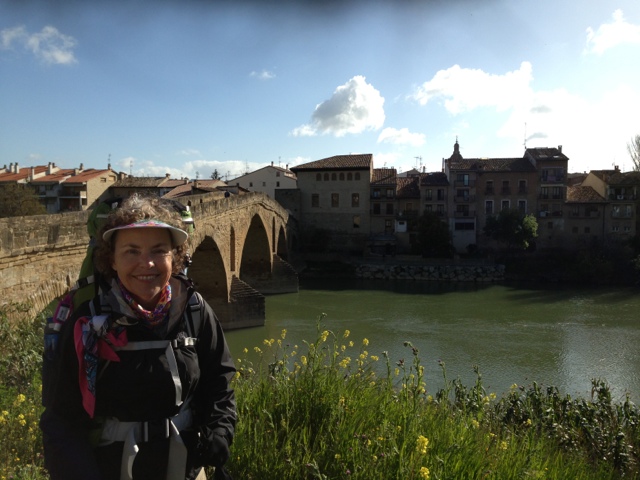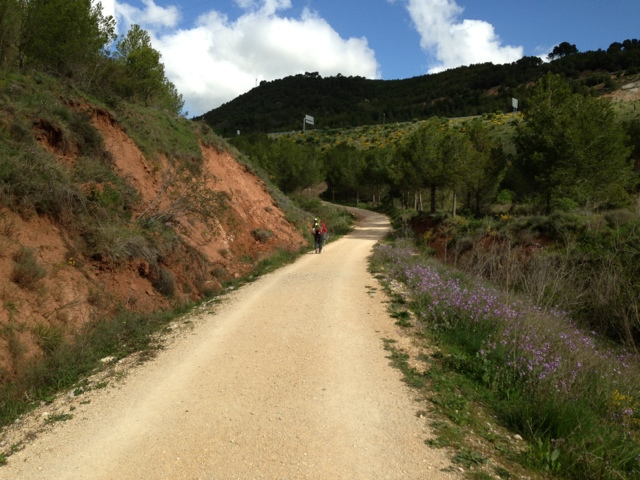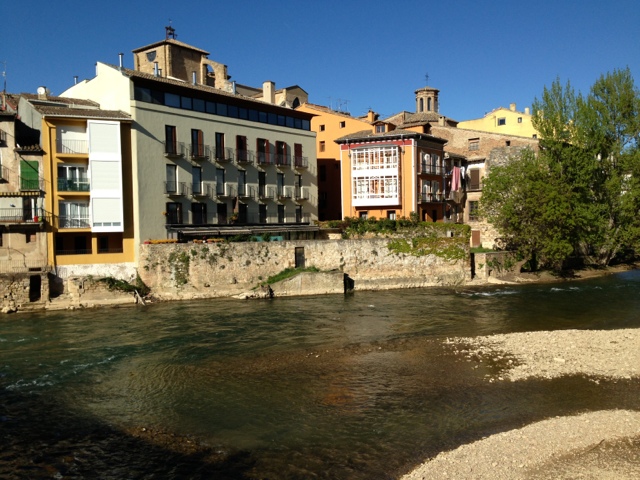Once we left Belorado two days ago, we entered into the region of Spain known as Castilla y Leon. Burgos is the historic capital of Castile and is now the capital of the province of Burgos and the autonomous community of Castile and Leon. This region is 11 times the size of Madrid but has a population of half of Madrid.
We will leave behind the vineyards and spend over 50% of our remaining time traveling through this region. Part of it will be on the incomparable "meseta" the flat table or plateau region that makes up a third of the Iberian (Spanish) peninsula.
But that is a discussion for tomorrow. Today was a "rest" day in Burgos and we chose well. The weather was frigid and windy. I had on 5 layers of clothing and was still cold.
We had a lovely breakfast at our hotel and continued to admire the view from our window of the Paseo Espolon and the Arlanzon River (photo 1). Then we walked a block down the street from our hotel to St. Mary's Arch, which was originally the main entrance to this medieval city. (photo 2)
At 10 we met our friend Brent for a tour of the Cathedral de Santa Maria. (Photos 3 and 4) It was started in 1221 because Burgos was becoming an important city in the region and needed a significant cathedral. The work began on the site of a Romanesque church, but was built in the Gothic style, which had become popular in France, particularly with the construction of Notre Dame. It was used as a church only 10 years later and consecrated in 1260 -- only 39 years after the first stone was laid, a record for the time.
It is a massive cathedral, with 19 chapels, each with paintings, sculptures, ornamentation, and ceiling detail. It took us 2 hours to hit the highlights, which included the Chapel of St. Anne, (photo 3), the Escalera Dorado (photo 4), which connected the cathedral to the street on one side since the ground was not level; the Chapel of the Virgin Mary (photo 5); and the main sanctuary (photo 6).
Afterwards we took a rest and then connected again for a tourist train ride, a perfect activity for a bad weather day. This gave us a nice overview of the city, although we had already seen most of the major sites.
Then Brent, Michele and I joined another friend Chris for dinner at El Cid restaurant and turned in early. We'll have an early start tomorrow morning when we're back on the Camino.
Monday, April 29, 2013
Sunday, April 28, 2013
Villafranca Montes de Oca to Burgos
We awoke to a very cold, blustery day with snow flurries. We had looked ahead to the forecast so we were not surprised. Walking up and down hills with a 1500 ft. accrued ascent was not in the picture.
We had already come up with a Plan B and for those of you who know me well, you know I am the Queen of Plan B.
Villafranca was the last city on the Camino with bus service into Burgos, about 22 miles. Since it was Sunday, the bus did not arrive until noon. We took advantage of the time to sleep in, have a communal breakfast with others at our lodging, and then hang out in the lobby of the Hotel San Anton Abad with other pilgrims enjoying its free WiFi.
Obviously, we were not the only ones with this great idea. By the time the bus pulled up, there were at least 20 of us freezing in the little shelter. (Photo 1) The bus was incredibly nice. The driver had us put our packs underneath and we rode the 40 minutes in luxury. All this for 2.42€. (About $3).
The bus station ended up being a very short walk to our hotel, the 4-star AC Marriott, which is right along the tree-lined Paseo del Espolon. We were overwhelmed. All this for 167€ for 2 nights with breakfast, complimentary cafe and tea in the lobby and a room with a tiny balcony overlooking the Rio Arlanzon.
We had a quick snack in the room and then headed to the Museum of Human Evolution, which was only open until 3. (Photo 2). It was an extremely modern building with state-of-the-art exhibits. Opened in 2010, the museum focuses on the oldest human fossil remains found in Europe unearthed in nearby Atapuerca. They were discovered in 1976 when a railroad was being built in the area. To date, they have discovered 28 individuals estimated to be 530,000 years old, predating the Neanderthal which is 200,000 years old.
What they discovered about these ancestors was quite interesting. Their stature was similar to ours but they were much heartier. There was the same difference in size between men and women as us. Most were right-handed. They were able to speak and they looked after their disabled. One example of the latter was the fact that a child's skeleton that showed a severe birth defect had lived to be 10 years old.
A significant part of the museum was devoted to Charles Darwin and the "Beagle Expedition" of 1831, when he traveled around the world and collected samples from many species of plants and animals. This led to his "Origin of the Species" in 1859.
Another interesting factoid from this museum is that menopause sets humans apart from other species. This led to the "grandmother hypothesis" - that grandmothers are supposed to help their children raise their grandchildren.
After the Museum, we climbed a hill behind the big cathedral (more on that tomorrow) to the ruins of a castle originally built in the 800's, but expanded over time. It was incredibly cold and windy at the top but the views from there were expansive. (Photos 3 and 4).
Then we walked through the streets of Burgos, past the Plaza Mayor and then strolled along Paseo Espolon where we were fascinated by the topiary-type sculpting of the trees (photos 5 and 6).
Tonight we ate dinner at the Casino Restaurant on the Plaza which was packed with locals, many of them older women grouped together at tables (I guess while the men were at bars). At 9 we were the only ones with real food in front of us. I don't know when they eat. Maybe at 10?
Then back to the hotel where we met up with Gary and Marjorie from Australia whom we met at the beginning of our trip. It's amazing how pilgrims keep connecting.
We had already come up with a Plan B and for those of you who know me well, you know I am the Queen of Plan B.
Villafranca was the last city on the Camino with bus service into Burgos, about 22 miles. Since it was Sunday, the bus did not arrive until noon. We took advantage of the time to sleep in, have a communal breakfast with others at our lodging, and then hang out in the lobby of the Hotel San Anton Abad with other pilgrims enjoying its free WiFi.
Obviously, we were not the only ones with this great idea. By the time the bus pulled up, there were at least 20 of us freezing in the little shelter. (Photo 1) The bus was incredibly nice. The driver had us put our packs underneath and we rode the 40 minutes in luxury. All this for 2.42€. (About $3).
The bus station ended up being a very short walk to our hotel, the 4-star AC Marriott, which is right along the tree-lined Paseo del Espolon. We were overwhelmed. All this for 167€ for 2 nights with breakfast, complimentary cafe and tea in the lobby and a room with a tiny balcony overlooking the Rio Arlanzon.
We had a quick snack in the room and then headed to the Museum of Human Evolution, which was only open until 3. (Photo 2). It was an extremely modern building with state-of-the-art exhibits. Opened in 2010, the museum focuses on the oldest human fossil remains found in Europe unearthed in nearby Atapuerca. They were discovered in 1976 when a railroad was being built in the area. To date, they have discovered 28 individuals estimated to be 530,000 years old, predating the Neanderthal which is 200,000 years old.
What they discovered about these ancestors was quite interesting. Their stature was similar to ours but they were much heartier. There was the same difference in size between men and women as us. Most were right-handed. They were able to speak and they looked after their disabled. One example of the latter was the fact that a child's skeleton that showed a severe birth defect had lived to be 10 years old.
A significant part of the museum was devoted to Charles Darwin and the "Beagle Expedition" of 1831, when he traveled around the world and collected samples from many species of plants and animals. This led to his "Origin of the Species" in 1859.
Another interesting factoid from this museum is that menopause sets humans apart from other species. This led to the "grandmother hypothesis" - that grandmothers are supposed to help their children raise their grandchildren.
After the Museum, we climbed a hill behind the big cathedral (more on that tomorrow) to the ruins of a castle originally built in the 800's, but expanded over time. It was incredibly cold and windy at the top but the views from there were expansive. (Photos 3 and 4).
Then we walked through the streets of Burgos, past the Plaza Mayor and then strolled along Paseo Espolon where we were fascinated by the topiary-type sculpting of the trees (photos 5 and 6).
Tonight we ate dinner at the Casino Restaurant on the Plaza which was packed with locals, many of them older women grouped together at tables (I guess while the men were at bars). At 9 we were the only ones with real food in front of us. I don't know when they eat. Maybe at 10?
Then back to the hotel where we met up with Gary and Marjorie from Australia whom we met at the beginning of our trip. It's amazing how pilgrims keep connecting.
Saturday, April 27, 2013
Belorado to Villafranca Montes de Oca
Esta nevando. "It is snowing" in Spanish. Didn't think I would need to know that phrase. However, when we woke up this morning, it was snowing and there was a light dusting on the nearby hills. (Photo1). We started out again around 8 am in our Altus raincoats, but it did stop about an hour into our walk. We made it to Tonsantos for our morning cafe con leche and were soon joined by our friends from Holland: Sabina, Geri and Perry and our friend Martin from Denmark from our night in Santo Domingo.
After a brief respite, we headed on through the countryside to Villambistia (photo 2). A very interesting church is located there and another of the ubiquitous fountains that dot the countryside for the thirsty pilgrims.(photos 3 and 4). Town also had a well-frequented bar/cafe, as evidenced by the backpacks outside.
Now the trail became very muddy and the clay soil (like Kentucky's) sticks to the bottoms of your boots like glue. It was slow going and the weather was in the 40's. The sauna-like raincoats actually felt good.
The next town, Epinosa del Camino, was barely a blimp, but it did have a small church.
We made it to Villafranca Montes de Oca (pop. 200) around noon and decided to call it a day. We had only done 8 miles but the next 8 miles was all up hill and down -- 3 times with a 1500 ft accrued ascent -- so we decided not to chance it in this weather. There are no stops along the way and the path would definitely be muddy. Besides, the destination only had an albuergue with 58 beds in 3 rooms or one small hotel. Not very inviting.
Instead, we stayed at La Alpargateria, a Casa Rural. We were the first ones and actually ended up with a suite for 36€. We walked around the small town and found the church, a store and a 3 star hotel. We bought food at a local super mercado (I have a closet bigger than that) and made lunch in the spacious kitchen at the inn. Later we were joined by young Emily from Pittsburgh and Carol and Dave from Australia. We 5 had this lovely place to ourselves. Many had decided to push it to San Juan.
This evening we had dinner at the fancy hotel. Apparently the owner of the hotel has traveled the Camino and wanted to give back to help pilgrims. So he built an albuergue next to his hotel and offers pilgrim meals at the hotel for 12€. So the dining room was full of hungry hikers eating the 3 course meal and inbibing in delicious bottles of Riojan wine. By dinner time, we had assembled a table of 9 and had friends at other large tables.
This was a special evening as it was Michele's 60th birthday. This was certainly a memorable way to enjoy it, although I know she was missing family. One of her well-wishers was Brent, who is currently from Barcelona but is originally from CA. He keeps showing up almost every day and is a delight.(photo 5).
Tomorrow we are headed to Burgos. We'll see what the weather brings.
After a brief respite, we headed on through the countryside to Villambistia (photo 2). A very interesting church is located there and another of the ubiquitous fountains that dot the countryside for the thirsty pilgrims.(photos 3 and 4). Town also had a well-frequented bar/cafe, as evidenced by the backpacks outside.
Now the trail became very muddy and the clay soil (like Kentucky's) sticks to the bottoms of your boots like glue. It was slow going and the weather was in the 40's. The sauna-like raincoats actually felt good.
The next town, Epinosa del Camino, was barely a blimp, but it did have a small church.
We made it to Villafranca Montes de Oca (pop. 200) around noon and decided to call it a day. We had only done 8 miles but the next 8 miles was all up hill and down -- 3 times with a 1500 ft accrued ascent -- so we decided not to chance it in this weather. There are no stops along the way and the path would definitely be muddy. Besides, the destination only had an albuergue with 58 beds in 3 rooms or one small hotel. Not very inviting.
Instead, we stayed at La Alpargateria, a Casa Rural. We were the first ones and actually ended up with a suite for 36€. We walked around the small town and found the church, a store and a 3 star hotel. We bought food at a local super mercado (I have a closet bigger than that) and made lunch in the spacious kitchen at the inn. Later we were joined by young Emily from Pittsburgh and Carol and Dave from Australia. We 5 had this lovely place to ourselves. Many had decided to push it to San Juan.
This evening we had dinner at the fancy hotel. Apparently the owner of the hotel has traveled the Camino and wanted to give back to help pilgrims. So he built an albuergue next to his hotel and offers pilgrim meals at the hotel for 12€. So the dining room was full of hungry hikers eating the 3 course meal and inbibing in delicious bottles of Riojan wine. By dinner time, we had assembled a table of 9 and had friends at other large tables.
This was a special evening as it was Michele's 60th birthday. This was certainly a memorable way to enjoy it, although I know she was missing family. One of her well-wishers was Brent, who is currently from Barcelona but is originally from CA. He keeps showing up almost every day and is a delight.(photo 5).
Tomorrow we are headed to Burgos. We'll see what the weather brings.
Friday, April 26, 2013
Santo Domingo de Calzada to Belorado
Into every life, a little rain must fall -- or is it on every Camino journey, you are gonna get wet, sooner or later. Today was our day. We started out in our lovely matching Altus ponchos (photo 1) and soon felt like we were in a sauna. Fortunately, the rain didn't last long and we were able to shed
them early.
Following the road out of the city, we crossed over the River Oja on another beautiful bridge (photo 2). This was the raging river that Santo Domingo had helped pilgrims cross but today it was a trickle.
We continued following country roads until we came to our first stop, Granon, where we found a lovely cafe. We joined several other pilgrims for our cafe con leche and croissant. We also stopped and got a stamp at a church and a bar, proving we were on the Camino today.
The skies started to clear, but there was mist over the rolling hills and everything started to look even greener than before. Today we had a number of villages along our route. One of the sights I love most is walking along these paths and suddenly seeing the church steeple in the next village come into view. (Photo 3) As we walk, a community emerges on the horizon and you anticipate the charm of entering yet another new place. Sometimes the charm is the church, a bridge, a fountain, a square, a shelter, etc. Each village seems to possess something of importance and often it is its link to the Camino.
Frequently, the key feature is the church and I am surprised how different many of them are. Even those that are very simple on the outside often have beautiful sanctuaries with carvings painted in gold. One church today in Viloria de la Rioja caught my eye because it was very different on the outside (it was locked, as many of them are.) This one did not have the high steeple and it was a combination of different stones, almost like a quilt. (Photo 4)
We are now entering the province of Burgos (photo 5) and plan to be in Burgos on Sunday.
Today we ended our journey in Belorado, adding 14 more miles for a total of 100 since we left Pamplona. We had some difficulty finding a place to stay but finally got a nice double room with bath for 45€ at Hotel Belardo on the far edge of town. We went back into town for dinner and ran into 3 pilgrim friends (2 from Holland and Paul from Australia) and had menu del dia (plate of the day) for 10€ at a restaurant on the Plaza Mayor (every town has one of them, too.) The menu del dia includes 2 courses (like salad and entre), desert and wine. Try getting that in the US for $13.
We walked back in a misty rain and prayed the sky would get it out of its system before tomorrow.
them early.
Following the road out of the city, we crossed over the River Oja on another beautiful bridge (photo 2). This was the raging river that Santo Domingo had helped pilgrims cross but today it was a trickle.
We continued following country roads until we came to our first stop, Granon, where we found a lovely cafe. We joined several other pilgrims for our cafe con leche and croissant. We also stopped and got a stamp at a church and a bar, proving we were on the Camino today.
The skies started to clear, but there was mist over the rolling hills and everything started to look even greener than before. Today we had a number of villages along our route. One of the sights I love most is walking along these paths and suddenly seeing the church steeple in the next village come into view. (Photo 3) As we walk, a community emerges on the horizon and you anticipate the charm of entering yet another new place. Sometimes the charm is the church, a bridge, a fountain, a square, a shelter, etc. Each village seems to possess something of importance and often it is its link to the Camino.
Frequently, the key feature is the church and I am surprised how different many of them are. Even those that are very simple on the outside often have beautiful sanctuaries with carvings painted in gold. One church today in Viloria de la Rioja caught my eye because it was very different on the outside (it was locked, as many of them are.) This one did not have the high steeple and it was a combination of different stones, almost like a quilt. (Photo 4)
We are now entering the province of Burgos (photo 5) and plan to be in Burgos on Sunday.
Today we ended our journey in Belorado, adding 14 more miles for a total of 100 since we left Pamplona. We had some difficulty finding a place to stay but finally got a nice double room with bath for 45€ at Hotel Belardo on the far edge of town. We went back into town for dinner and ran into 3 pilgrim friends (2 from Holland and Paul from Australia) and had menu del dia (plate of the day) for 10€ at a restaurant on the Plaza Mayor (every town has one of them, too.) The menu del dia includes 2 courses (like salad and entre), desert and wine. Try getting that in the US for $13.
We walked back in a misty rain and prayed the sky would get it out of its system before tomorrow.
Thursday, April 25, 2013
Azofra to Santo Domingo de Calzada
We started the day at 8:30 after a pilgrim's breakfast of coffee con leche and the biggest croissant I have ever seen. (Photo 1)
Today's journey was mostly country roads crossing through undulating farmlands. The views go in all directions and are hard to take in. (Photo 2) Our first stop was a small pilgrim's park where others had already stopped for a rest.
We then went through Rioja Alta Golf Club. Although there seemed to be a nice golf course, there were numerous condos that appeared uninhabited -- one of those developments that may have fallen prey to the economy. We passed by the only bar/restaurant and on into Ciruena. It was smaller than we imagined and I'm glad we didn't have to stay there.
Our next destination was Santo Domingo de Calzada (pop. 5,600). We ate our picnic lunch in front of the monastery turned hostel and contemplated our plan. (Photo 3 is fountain in front)
Although it was now only 1 pm, we decided that this was a town worth seeing and called it a day, having traveled only 10 miles. We also treated ourselves to nice accommodations and found a lovely room for 58€ at Hospederia Cisterciense, a brand new 2 star hotel run by the same nuns who run the monastery albergue. Smart nuns.
We then decided to explore the town, but by 2 pm, the bustling community we had walked into an hour before had gone to sleep. All the shops closed up, even groceries. How does an economy function like this? It has baffled me for years.
We were able to go to the Cathedral of Santo Domingo de la Calzada, which is also a museum and costs 3€. It is named after a hermit who decided to devote his life to helping pilgrims in 1040. He worked to build a bridge over the River Oja, establish a hospital and build a little church. (The hospital is now a 4-star hotel.)
The Cathedral was impressive. I know, you will tire of hearing about cathedrals, bridges and water fountains in the coming days, but this one is different. Construction started in 1158 but much of the real architecture occurred in the 14th-16th centuries. What was most impressive were the stark clean lines of three naves with rib vaults at the laterals and 8 ribs in the central vault. They are void of the usual decorations or sculptures, due to the lack of economic resources at the time. (Photo 4) The remains of Santo Domingo are buried there in a crypt on the lower level with a burial laude (sculpture of him lying on his deathbed) on the main floor.
But perhaps the most unusual aspect of the church is the gothic hen house which was built in the 15th century to house a hen and a rooster in memory of one of Santo Domingo's miracles. There are live birds in the cage. It is too lengthy a story for here, but roosters and hens have also become symbols for the city.
We waited out the rest of siesta and then headed out for drinks around 6. We ran into 2 of our friends from Holland and had drinks at a cafe along Paseo del Espol. We were then joined by Perry from Holland and Martin from Denmark. (Martin is a dead ringer in all ways to my friend Dave Linthicum in Maryland. He was very knowledgeable about films and politics, two of my favorite subjects.) We had paella at the cafe for dinner and topped it off with a sweet treat from a shop in town. Another memorable evening in Spain.
Today's journey was mostly country roads crossing through undulating farmlands. The views go in all directions and are hard to take in. (Photo 2) Our first stop was a small pilgrim's park where others had already stopped for a rest.
We then went through Rioja Alta Golf Club. Although there seemed to be a nice golf course, there were numerous condos that appeared uninhabited -- one of those developments that may have fallen prey to the economy. We passed by the only bar/restaurant and on into Ciruena. It was smaller than we imagined and I'm glad we didn't have to stay there.
Our next destination was Santo Domingo de Calzada (pop. 5,600). We ate our picnic lunch in front of the monastery turned hostel and contemplated our plan. (Photo 3 is fountain in front)
Although it was now only 1 pm, we decided that this was a town worth seeing and called it a day, having traveled only 10 miles. We also treated ourselves to nice accommodations and found a lovely room for 58€ at Hospederia Cisterciense, a brand new 2 star hotel run by the same nuns who run the monastery albergue. Smart nuns.
We then decided to explore the town, but by 2 pm, the bustling community we had walked into an hour before had gone to sleep. All the shops closed up, even groceries. How does an economy function like this? It has baffled me for years.
We were able to go to the Cathedral of Santo Domingo de la Calzada, which is also a museum and costs 3€. It is named after a hermit who decided to devote his life to helping pilgrims in 1040. He worked to build a bridge over the River Oja, establish a hospital and build a little church. (The hospital is now a 4-star hotel.)
The Cathedral was impressive. I know, you will tire of hearing about cathedrals, bridges and water fountains in the coming days, but this one is different. Construction started in 1158 but much of the real architecture occurred in the 14th-16th centuries. What was most impressive were the stark clean lines of three naves with rib vaults at the laterals and 8 ribs in the central vault. They are void of the usual decorations or sculptures, due to the lack of economic resources at the time. (Photo 4) The remains of Santo Domingo are buried there in a crypt on the lower level with a burial laude (sculpture of him lying on his deathbed) on the main floor.
But perhaps the most unusual aspect of the church is the gothic hen house which was built in the 15th century to house a hen and a rooster in memory of one of Santo Domingo's miracles. There are live birds in the cage. It is too lengthy a story for here, but roosters and hens have also become symbols for the city.
We waited out the rest of siesta and then headed out for drinks around 6. We ran into 2 of our friends from Holland and had drinks at a cafe along Paseo del Espol. We were then joined by Perry from Holland and Martin from Denmark. (Martin is a dead ringer in all ways to my friend Dave Linthicum in Maryland. He was very knowledgeable about films and politics, two of my favorite subjects.) We had paella at the cafe for dinner and topped it off with a sweet treat from a shop in town. Another memorable evening in Spain.
Wednesday, April 24, 2013
Navarette to Azofra
As we walked through fields and fields of vineyards interspersed with "bodegas" (wineries), I have to feel we are in the Napa Valley of Spain. Makes me want to come back and just do a wine tasting tour of La Rioja. Do they even have them? I'll spare you all the vineyard photos but this one (photo 1) was interesting from an artistic standpoint.
We left our lovely albergue at 8:20 on another beautiful sunny morning and headed out of town on a cobbled street that soon turned into a country path of red Riojan earth. We passed by the village of Sotes and made it to Ventosa for our first stop of the day. We settled at a popular bar/cafe where we encountered a number of pilgrims.
I saw a man there from the States whom I had helped secure a bed at our albergue the previous night. We started chatting and I discovered his Camino story. It was a very sad one and resembled the story from the movie "The Way," complete with a tin box in his pack. I sent my prayers with him. We met another man at the bar, also from the states, who is doing the walk with an artificial leg. He is having some mechanical problems but is determined to make it. The 2 men were only the third and fourth Americans I have met on the trail. Most pilgrims are from European countries or Australia. Many from the latter.
We continued on the vineyard lined trail as the wind picked up speed. In one of the fields, we came upon a stone bee hive hut with seating inside. (Photo 2) By that time the wind must have been 40 mph so we decided to have our lunch in the hive. We were soon joined by several other pilgrims doing the same thing.
From there we journeyed to Najera, (pop. 7,000) arriving about 1 pm, much too early to end the day. It was a beautiful city, once the capital of Navarre in the 11th and 12th centuries. It was very modern, with roundabouts (photo 3), and beautiful bridges (photos 4 and 5) over the Rio Najerilla. We crossed a foot bridge into the old town, found the tourist office, and then decided to make it to Azofra, a day ahead of schedule. The 4 miles there was uneventful except for the markers clicking off kilometers to Santiago. (Photo 6) we have done over 100 kilometers!
We arrived in Azofra around 3, clocking in around 14 miles, and decided to stay at the new Municipal Albergue, which has 60 beds in cubicles with 2 beds and bathrooms down the hall. Reminded me of college. At 7€, it is a pretty good deal. Then we joined some other pilgrims for a 10€ meal (with wine) at a nearby bar and called it a night.
We left our lovely albergue at 8:20 on another beautiful sunny morning and headed out of town on a cobbled street that soon turned into a country path of red Riojan earth. We passed by the village of Sotes and made it to Ventosa for our first stop of the day. We settled at a popular bar/cafe where we encountered a number of pilgrims.
I saw a man there from the States whom I had helped secure a bed at our albergue the previous night. We started chatting and I discovered his Camino story. It was a very sad one and resembled the story from the movie "The Way," complete with a tin box in his pack. I sent my prayers with him. We met another man at the bar, also from the states, who is doing the walk with an artificial leg. He is having some mechanical problems but is determined to make it. The 2 men were only the third and fourth Americans I have met on the trail. Most pilgrims are from European countries or Australia. Many from the latter.
We continued on the vineyard lined trail as the wind picked up speed. In one of the fields, we came upon a stone bee hive hut with seating inside. (Photo 2) By that time the wind must have been 40 mph so we decided to have our lunch in the hive. We were soon joined by several other pilgrims doing the same thing.
From there we journeyed to Najera, (pop. 7,000) arriving about 1 pm, much too early to end the day. It was a beautiful city, once the capital of Navarre in the 11th and 12th centuries. It was very modern, with roundabouts (photo 3), and beautiful bridges (photos 4 and 5) over the Rio Najerilla. We crossed a foot bridge into the old town, found the tourist office, and then decided to make it to Azofra, a day ahead of schedule. The 4 miles there was uneventful except for the markers clicking off kilometers to Santiago. (Photo 6) we have done over 100 kilometers!
We arrived in Azofra around 3, clocking in around 14 miles, and decided to stay at the new Municipal Albergue, which has 60 beds in cubicles with 2 beds and bathrooms down the hall. Reminded me of college. At 7€, it is a pretty good deal. Then we joined some other pilgrims for a 10€ meal (with wine) at a nearby bar and called it a night.
Tuesday, April 23, 2013
Viana to Navarrete
Today we cross from Navarre into the famous wine growing region of La Rioja. This morning we were blessed with gorgeous weather. Lots of sun and almost no wind.
We left our very private abode around 8:00 and followed a peaceful path around the back of houses and old factory buildings, along a park-like trail, for 2 miles until we reached Ermita de la Trinidad de Cuevas. This was the former site of an earlier pilgrim hostel along a tributary of the Ebro River. A small picnic spot with a grove of trees welcomed several pilgrims who had already stopped for their morning break or to reflect in their journals. (Photo 1)
We walked along quite a few paved paths as we made our way to Logrono. What has surprised me is the infrastructure that has developed for the Camino. Various communities along the way have placed markers in the sidewalks to direct pilgrims or have placed distinctive road signs. In places where the route might cross the highway, they have built pedestrian overpasses or even stone underpasses. We encountered several of these today.
Our walk to Logrono included views of many vineyards with the Cantabrian Hills in the background.(photo 2) Just as we were about to enter town, we stopped at the small shop of the legendary Felisa, who, for a few coins, would stamp our Camino passports, provide a coffee con leche or sell you symbolic trinkets.(photo 3)
The walk into Logrono was beautiful. We stopped at an overlook where the city was spread out before us. (Photo 4) We then walked down a tree lined path through a park and crossed over the Ebro River on the Puente de Piedra, rebuilt in 1880, and arched like other Spanish bridges.
We spent an hour or so exploring Logrono, visiting the Plaza Mercado with its shops and cafes, and the impressive Cathedral de Santa Maria de la Redonda, a 14th century Gothic structure in the heart of old town. Logrono is a size able city with 145,000 residents.
The Camino took us through the more modern parts of the city as well (photo 5) and the signs became a little confusing. Several older women (older than us) stopped us to wish us well or to point us in the right direction. Ah, the sisterhood of the Camino. At one point, on the out skirts of the city, we were following a paved linear park walk when two younger women came running toward us to tell us we had missed the turn. Another time a man stopped us to warn us to take the tunnel under the highway. All of this was in Spanish, of course, so there was lots of gesturing and pointing.
The path leading out of Logrono was beautiful, with a paved path leading to a wide reservoir where many locals were fishing and and picnicking. The trail climbed a bit and we found ourselves at Alto de la Grajera, with wide views again of the beautiful city. We continued on both paved and dirt tracks, and even some highway until we reached the city of Navarette, our destination for the night. We arrived about 3:30, having walked 14 miles. Again, we snagged the last double room at a beautiful new Albergue La Cantaro for 15€ each, sharing 2 Baths with 3 other people. After our usual routine of showering and laundry, we explored the city. We ran into a number of pilgrims we have met before and had drinks and snacks with them at a local bar, which made for a nice, light dinner. Back to the albergue where we caught up with email and Skype and called it a day.
We left our very private abode around 8:00 and followed a peaceful path around the back of houses and old factory buildings, along a park-like trail, for 2 miles until we reached Ermita de la Trinidad de Cuevas. This was the former site of an earlier pilgrim hostel along a tributary of the Ebro River. A small picnic spot with a grove of trees welcomed several pilgrims who had already stopped for their morning break or to reflect in their journals. (Photo 1)
We walked along quite a few paved paths as we made our way to Logrono. What has surprised me is the infrastructure that has developed for the Camino. Various communities along the way have placed markers in the sidewalks to direct pilgrims or have placed distinctive road signs. In places where the route might cross the highway, they have built pedestrian overpasses or even stone underpasses. We encountered several of these today.
Our walk to Logrono included views of many vineyards with the Cantabrian Hills in the background.(photo 2) Just as we were about to enter town, we stopped at the small shop of the legendary Felisa, who, for a few coins, would stamp our Camino passports, provide a coffee con leche or sell you symbolic trinkets.(photo 3)
The walk into Logrono was beautiful. We stopped at an overlook where the city was spread out before us. (Photo 4) We then walked down a tree lined path through a park and crossed over the Ebro River on the Puente de Piedra, rebuilt in 1880, and arched like other Spanish bridges.
We spent an hour or so exploring Logrono, visiting the Plaza Mercado with its shops and cafes, and the impressive Cathedral de Santa Maria de la Redonda, a 14th century Gothic structure in the heart of old town. Logrono is a size able city with 145,000 residents.
The Camino took us through the more modern parts of the city as well (photo 5) and the signs became a little confusing. Several older women (older than us) stopped us to wish us well or to point us in the right direction. Ah, the sisterhood of the Camino. At one point, on the out skirts of the city, we were following a paved linear park walk when two younger women came running toward us to tell us we had missed the turn. Another time a man stopped us to warn us to take the tunnel under the highway. All of this was in Spanish, of course, so there was lots of gesturing and pointing.
The path leading out of Logrono was beautiful, with a paved path leading to a wide reservoir where many locals were fishing and and picnicking. The trail climbed a bit and we found ourselves at Alto de la Grajera, with wide views again of the beautiful city. We continued on both paved and dirt tracks, and even some highway until we reached the city of Navarette, our destination for the night. We arrived about 3:30, having walked 14 miles. Again, we snagged the last double room at a beautiful new Albergue La Cantaro for 15€ each, sharing 2 Baths with 3 other people. After our usual routine of showering and laundry, we explored the city. We ran into a number of pilgrims we have met before and had drinks and snacks with them at a local bar, which made for a nice, light dinner. Back to the albergue where we caught up with email and Skype and called it a day.
Monday, April 22, 2013
Los Arcos to Viana
We passed through the medieval portal (I love that word) juxtaposed to the opulent Church of St. Mary of the Arches (photo 1) and onto the Camino, leaving our Hostal around 8:30. It was very cool and cloudy, not what we were expecting, but thank goodness, no rain.
Anyone who is a fan of James Taylor can imagine I was humming his song "Walking Down a Country Road" as I journeyed today. Most of today was on natural paths and dirt tracks through arable farmlands, many of which are devoted to vineyards. We are in Rioja, after all, the famous wine-producing region in Spain.
Our first stop was in Sansol, where a pilgrim "tienda" had attracted a number of walkers. We reconnected with some former acquaintances and, of course, took advantage of the single bathroom.
From there it was a short walk across a small river into Torres del Rio (photo 2). Here I visited the 12th century church Iglesia de Santo Sepulcro linked with the Knights Templar and based on the octagonal church of the Holy Sepulchre in Jerusalem.
The rest of the day was rolling hills and farmlands, but often with paved trails and always well marked. (photo 3) Lunch was a brief stop with carried sandwiches under pine trees with an assortment of nationalities.
We arrived in the village of Viana about 1:30 and had an unusual experience. We tried to get a double room at an albergue that was full. But the woman called her sister(?) who came and got us and took us to a beautiful albergue with 8 beds in 3 rooms and 2 baths. We had a room to ourselves. But the woman handed us keys to the front door and told us where to leave them in the morning. Then she left and never came back. Later that night a young couple from Nova Scotia, whom we had met previously, joined us. The 4 of us had this lovely, new, quiet 3 story dwelling to ourselves. Interesting.
We then explored the town and found it delightful. We located the Iglesia Santa Maria, (photo 4) a huge 13th century church situated on the Plaza de Los Fueros with its central fountain and across from the town hall. Continuing on, we toured the ruins of the Church of St. Peter, which must have been enormous, and they were painstakingly restoring some of the medieval frescoes on the remaining walls. We then walked along a lovely sidewalk which seemed to circumvent the old city and we saw the ancient defensive walls on the west side.
We found free WiFi at the library and then had dinner at a popular pilgrim hangout, La Taverna. A group of 8 or so Australian women, with whom we had shared accommodations the past two nights, were there celebrating their last big night on the Camino. They were a delightful group and we are sorry to see them end their trip so soon.
Today we completed 12 more miles of our journey.
Anyone who is a fan of James Taylor can imagine I was humming his song "Walking Down a Country Road" as I journeyed today. Most of today was on natural paths and dirt tracks through arable farmlands, many of which are devoted to vineyards. We are in Rioja, after all, the famous wine-producing region in Spain.
Our first stop was in Sansol, where a pilgrim "tienda" had attracted a number of walkers. We reconnected with some former acquaintances and, of course, took advantage of the single bathroom.
From there it was a short walk across a small river into Torres del Rio (photo 2). Here I visited the 12th century church Iglesia de Santo Sepulcro linked with the Knights Templar and based on the octagonal church of the Holy Sepulchre in Jerusalem.
The rest of the day was rolling hills and farmlands, but often with paved trails and always well marked. (photo 3) Lunch was a brief stop with carried sandwiches under pine trees with an assortment of nationalities.
We arrived in the village of Viana about 1:30 and had an unusual experience. We tried to get a double room at an albergue that was full. But the woman called her sister(?) who came and got us and took us to a beautiful albergue with 8 beds in 3 rooms and 2 baths. We had a room to ourselves. But the woman handed us keys to the front door and told us where to leave them in the morning. Then she left and never came back. Later that night a young couple from Nova Scotia, whom we had met previously, joined us. The 4 of us had this lovely, new, quiet 3 story dwelling to ourselves. Interesting.
We then explored the town and found it delightful. We located the Iglesia Santa Maria, (photo 4) a huge 13th century church situated on the Plaza de Los Fueros with its central fountain and across from the town hall. Continuing on, we toured the ruins of the Church of St. Peter, which must have been enormous, and they were painstakingly restoring some of the medieval frescoes on the remaining walls. We then walked along a lovely sidewalk which seemed to circumvent the old city and we saw the ancient defensive walls on the west side.
We found free WiFi at the library and then had dinner at a popular pilgrim hangout, La Taverna. A group of 8 or so Australian women, with whom we had shared accommodations the past two nights, were there celebrating their last big night on the Camino. They were a delightful group and we are sorry to see them end their trip so soon.
Today we completed 12 more miles of our journey.
Sunday, April 21, 2013
Estella to Los Arcos
Last night we treated ourselves to a private room in the small Hostal Christina. We were very excited to get the last available room and have it located on the second floor overlooking the edge of the main Plaza de Los Fueros and the San Juan Bautista Church. What we didn't consider is that the Spanish love to party late at night. There seemed to be a major celebration going on outside our window until 4:30 am at which time the church bells started ringing every 30 minutes in preparation for Sunday services (and the party stopped).
But we did enjoy our evening in Estella. We walked the streets and the bridges over the Rio Ega, looking at some of the beautiful old churches and village plazas. The town was established in 1090 specifically to provide overnight shelter for pilgrims. Today it is a vibrant town of 15,000 with a modern section.
The weather was sunny but cool as we headed out of town. We didn't leave until 9 because we slept in and had breakfast at a local cafe with WiFi.
We walked past the Irache Monastery and then our first stop -- the free wine fountain provided by the Bodegas Irache winery. Even though it was just after breakfast, we had a taste, but determined it was not their best. (Like we're experts.)
Most of today we traveled on rolling natural paths which meandered through large scrub oak trees (Holm Oak) and some pine trees, but the majority of the path skirted vineyards - rows and rows of them. It is obvious why Navarre is the wine producing region of Spain.
We passed through the tiny village of Azqueta with its large parish church. There we found a handy little store that catered to pilgrims and had a bathroom. These are always a treat. Met up with a couple from Australia that we have walked with several times.
We had packed our lunches and stopped by one of the many ancient fountains along the Camino to eat. Apparently, the water is so good that people drive up in their cars and fill multiple bottles, as one man did while we were there.
Our next stop was Villamayor de Monjardin, another beautiful little village, but noteworthy because of the conical peak of Monjardin with the ruins of St. Stephen's Castle forming a distinctive backdrop to the village.
We ended our day about 3 pm at Los Arcos, completing 13 miles today, bringing our 3 day total to 40. Not bad for a beginning.
Again, we decided we needed a goodnight's sleep so we snagged the last room (again) at Pension Mavi, near Plaza de Santa Maria. Seems there really are a lot of pilgrims this time of year. The plaza had a bar and a restaurant with outdoor seating where many other pilgrims enjoyed their evening libations. We were joined by a few we had met several times before. We also went into the Church of Santa Maria and were awed by the amount of gold in the nave especially for a city of 1300.
We turned in early, not sure what tomorrow will bring.
Photos:
1) Estrella- old central fountain with former city hall with Baroque facade facing and, on right, 12th century Palace of the Kings of Navarre.
2) Church of San Pedro,
3) Fuente del Vino
4) Countryside
5) Ruins of old Pilgrim hospital
But we did enjoy our evening in Estella. We walked the streets and the bridges over the Rio Ega, looking at some of the beautiful old churches and village plazas. The town was established in 1090 specifically to provide overnight shelter for pilgrims. Today it is a vibrant town of 15,000 with a modern section.
The weather was sunny but cool as we headed out of town. We didn't leave until 9 because we slept in and had breakfast at a local cafe with WiFi.
We walked past the Irache Monastery and then our first stop -- the free wine fountain provided by the Bodegas Irache winery. Even though it was just after breakfast, we had a taste, but determined it was not their best. (Like we're experts.)
Most of today we traveled on rolling natural paths which meandered through large scrub oak trees (Holm Oak) and some pine trees, but the majority of the path skirted vineyards - rows and rows of them. It is obvious why Navarre is the wine producing region of Spain.
We passed through the tiny village of Azqueta with its large parish church. There we found a handy little store that catered to pilgrims and had a bathroom. These are always a treat. Met up with a couple from Australia that we have walked with several times.
We had packed our lunches and stopped by one of the many ancient fountains along the Camino to eat. Apparently, the water is so good that people drive up in their cars and fill multiple bottles, as one man did while we were there.
Our next stop was Villamayor de Monjardin, another beautiful little village, but noteworthy because of the conical peak of Monjardin with the ruins of St. Stephen's Castle forming a distinctive backdrop to the village.
We ended our day about 3 pm at Los Arcos, completing 13 miles today, bringing our 3 day total to 40. Not bad for a beginning.
Again, we decided we needed a goodnight's sleep so we snagged the last room (again) at Pension Mavi, near Plaza de Santa Maria. Seems there really are a lot of pilgrims this time of year. The plaza had a bar and a restaurant with outdoor seating where many other pilgrims enjoyed their evening libations. We were joined by a few we had met several times before. We also went into the Church of Santa Maria and were awed by the amount of gold in the nave especially for a city of 1300.
We turned in early, not sure what tomorrow will bring.
Photos:
1) Estrella- old central fountain with former city hall with Baroque facade facing and, on right, 12th century Palace of the Kings of Navarre.
2) Church of San Pedro,
3) Fuente del Vino
4) Countryside
5) Ruins of old Pilgrim hospital
Saturday, April 20, 2013
Uterga to Estella
If I ever needed a reason to do the Camino, it became obvious today -- the scenery is spectacular. We were blessed with another beautiful, sunny, but cool, day.
We left the albergue at 7 after being abruptly awakened at 6 by an automatic ceiling light. But it was fine because the day beckoned. The Camino trail took us through some exquisite countryside that resembled a patchwork quilt with its multiple shades of greens and yellows. We headed through Muruzabal and Obamos and made it to Puente de la Reina by 9:30. We stopped for some great pastry and cafe con leche at a little cafe and were joined by fellow pilgrim Helen from Canada. We had a pleasant walk through the city and stopped to admire the bridge, the city's namesake, which crosses the Arga River.
From there we headed through Maneru continuing on some lovely country lanes, . In the distance we could see Cirauqui, which looked like something from a storybook. However, the closer we got, we could see it was somewhat aged, but still had color. The path from there followed an old Roman road and then came to medieval stone bridge that crossed the Salt River.
We were feeling great so we kept on going to Lorca and Villatuerta and made it all the way to Estella -- 17 miles today!
We left the albergue at 7 after being abruptly awakened at 6 by an automatic ceiling light. But it was fine because the day beckoned. The Camino trail took us through some exquisite countryside that resembled a patchwork quilt with its multiple shades of greens and yellows. We headed through Muruzabal and Obamos and made it to Puente de la Reina by 9:30. We stopped for some great pastry and cafe con leche at a little cafe and were joined by fellow pilgrim Helen from Canada. We had a pleasant walk through the city and stopped to admire the bridge, the city's namesake, which crosses the Arga River.
From there we headed through Maneru continuing on some lovely country lanes, . In the distance we could see Cirauqui, which looked like something from a storybook. However, the closer we got, we could see it was somewhat aged, but still had color. The path from there followed an old Roman road and then came to medieval stone bridge that crossed the Salt River.
We were feeling great so we kept on going to Lorca and Villatuerta and made it all the way to Estella -- 17 miles today!
Subscribe to:
Posts (Atom)
